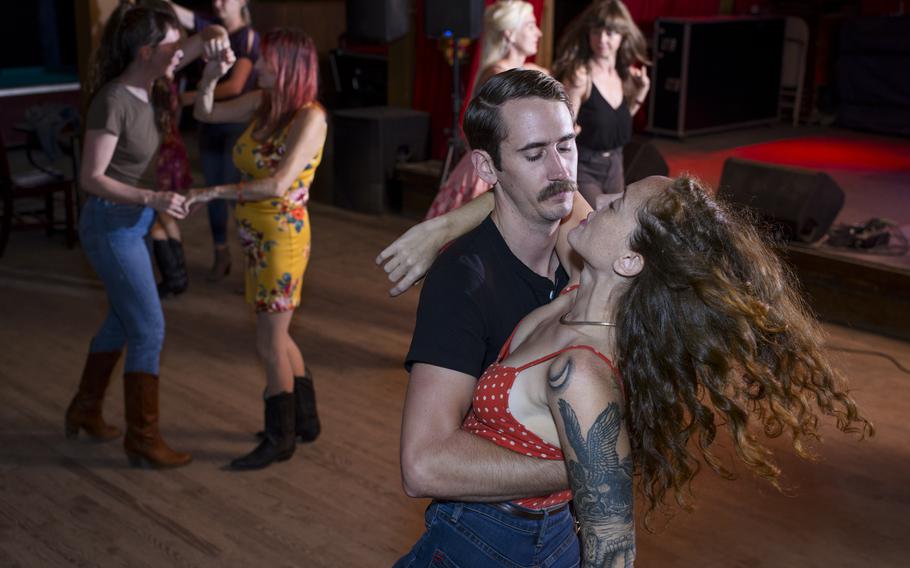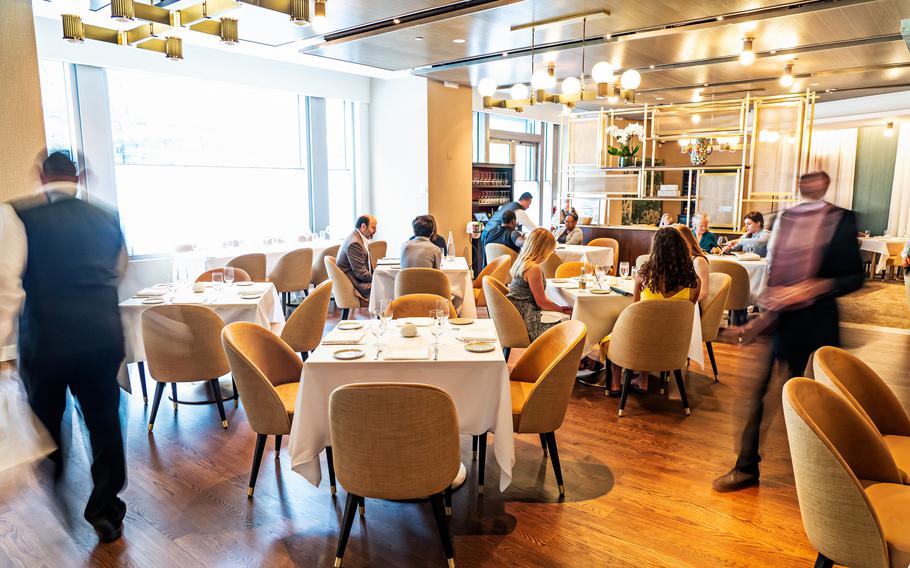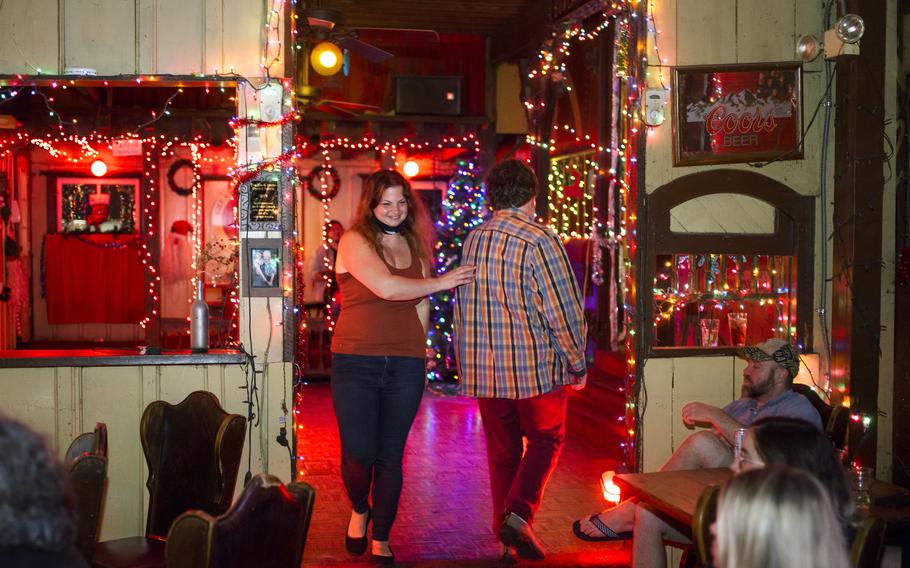U.S.
Americans emerge after pandemic isolation: ‘Like the end of prohibition’
The Washington Post June 5, 2021

Steven Clarke and Stephanie Gregory, in foreground, two-step during a dance lesson at Sagebrush bar in Austin, Texas, on June 3, 2021. (Matthew Busch/for The Washington Post)
American life is roaring back as a slew of states eased or dropped pandemic restrictions in time for Memorial Day weekend and are preparing to lift the few remaining coronavirus control measures, from mask mandates to restaurant capacity limits, in the coming weeks.
In large swaths of the country, the holiday weekend that traditionally marks the unofficial start of the summer also kicked off a post-vaccine return to normalcy.
Last call in Kentucky bars stretched early into Friday night after the governor lifted an 11 p.m. curfew. Gamblers on a Boston casino floor counted down to 12:01 a.m. Saturday when Massachusetts restrictions ended, chanting “it’s all over” as they ripped off their masks, sipped champagne and watched workers remove Plexiglas slot machine dividers. Jersey Shore revelers rushed to reopened dance floors.
The home arenas of NBA teams including the Boston Celtics, New York Knicks, Miami Heat, Philadelphia 76ers and Milwaukee Bucks have recently been filled to near or full capacity. Most MLB ballparks plan to lift capacity restrictions by July 5, according to tracking by the Athletic.
The developments come as half of eligible Americans have received at least one coronavirus vaccine dose, although President Joe Biden’s goal of hitting 70% by the Fourth of July looks out of reach as the pace of shots slows drastically. The seven-day average of daily new cases has dipped below 20,000 for the first time since March 2020, and the Centers for Disease Control and Prevention dubbed no state as “high risk” for coronavirus transmission this week. For once, public health experts don’t have to be the party poopers about holiday gatherings — at least, for the vaccinated.
“You may see some vestiges of outbreaks in particular areas that have lower vaccination rates, but they’ll be harder to sustain themselves and actually grow into these major outbreaks,” said Dave Rubin, director of PolicyLab at Children’s Hospital of Philadelphia.
The virus remains a present danger, particularly for the unvaccinated. The U.S. death toll is on the brink of crossing 600,000 as hundreds die daily. Unvaccinated people face higher risk of infection as the virus seeks out those without immunity, and their hospitalization rates have been steady. New virus variants remain a looming threat, though the vaccines still appear to prove an effective shield.
And the United States remains a global anomaly, given the widespread availability of vaccine doses here while regions such as Southeast Asia are in the throes of deadly spikes.
Nevertheless, governors and U.S. public health authorities in even some of the most cautious jurisdictions say the risks of overrun hospitals and uncontrolled outbreaks are so low that restrictions can come to an end after 14 months.
Nightclubs in Boston scrambled to staff their bars and revive their sound systems in time for the Memorial Day weekend reopening — well before the August goal originally set by Gov. Charlie Baker, R. Royale, the largest club in Boston’s theater district, hit its 1,200-person capacity before midnight and had to turn away some customers who had waited in line for more than an hour.
“It felt like the end of prohibition, that everyone wants to come out and celebrate,” said Jamison LaGuardia, vice president for sales, operations and events at Royale Entertainment Group.

The dining room at Tosca restaurant on May 28, 2021, in Washington, DC. (Scott Suchman/for The Washington Post)
After Virginia Gov. Ralph Northam, D, lifted all remaining business restrictions on May 28, Barb and Chuck Moody returned to the neighborhood bar in Leesburg where they used to drink every week. They ordered a Pinot Grigio and Pilsener, chatted up the bartender they got to know before the pandemic and regaled a couple seated nearby with their firsthand account of the streaker who slid across a rain-soaked tarp at a Washington Nationals game last week.
“It was like old times,” said Barb Moody, a 66-year-old retired marketing executive. “People are friendlier than they used to be, because they are like, ‘Oh, another human! We can talk!’ “
Some reopenings have come with mixed emotion.
Tony Chesak, who leads the Minnesota Licensed Beverage Association, said little fanfare accompanied reopenings for many of the bars and restaurants that his association represents. Some put up signs warning customers of slow service because of staffing shortages. Others are finding it tough to be ecstatic when their focus is recouping the equivalent or two or three years of lost profit.
“Things had gone on for so long that I think folks were just tired,” Chesak said. “Tired and broke.”
Elsewhere, people are reemerging for the first time. It can feel like blinking wildly after stepping into the sunlight after days in a cave.
Chris Baittinger, a 48-year-old chef, on Thursday traveled from Wilmington, Del., to an upscale kitchenware store in South Philadelphia. He was glad to be one of only five customers in the store, even though he’s fully vaccinated.
“Some people are like teenagers after being grounded for three weeks, running around acting crazy. Me, I’m just kind of cautious,” he said. “I might go here, I might go there. If it gets too crowded, I might bounce out.”
As has been the case throughout the pandemic, the road to reopening looks different depending on where you live. A patchwork of inconsistent policies across and within states has left some businesses and customers confused.
A slew of Republican-run states, from Wyoming to Texas to Florida, have been fully reopened since spring. In red and blue states alike, major cities have lagged behind suburban and urban areas in removing restrictions.
In Minnesota, St. Paul and Minneapolis waited until after the holiday weekend to fully reopen bars and restaurants. Nokomis Beach Coffee in Minneapolis reported confrontations in recent weeks when customers from the suburbs — where there was no mask mandate — stopped for a caffeine fix on their way to Lake Nokomis, only to be reminded to cover their face.
“People are very offended when you call them out on something,” said owner Dennis Kloek.
Impatience is simmering in corners of the country where not much changed over Memorial Day weekend.
In April, New Mexico Gov. Michelle Lujan Grisham, D, announced plans to lift most limitations once 60% of eligible New Mexicans were vaccinated. But late last month, she said the state would wait two weeks past that point to ensure the vaccines have taken effect. With 56 percent of the state fully vaccinated, a full reopening is still weeks away.
Carol Wight, CEO of the New Mexico Restaurant Association, said members are frustrated by the shifting timelines, especially while neighboring states are returning to normal.
“We’ve got Arizona on one side and Texas on the other side, and they’ve been mostly open,” Wight said. “Even Colorado, which also has a Democratic governor, has been much more open than New Mexico. So that’s been a frustration.”

Bartender Michelle Beebe, left, says hi to a customer at Donn's Depot, a piano bar in Austin, on June 3, 2021. (Matthew Busch/for The Washington Post)
A revised public health order that preserves a 33 percent capacity limit on enclosed New Mexico bars and entertainment venues Lujan Grisham issued Wednesday appears to have outdated language about “devastating effects” from a “rapid increase in COVID-19 cases,” which are actually declining. State health officials did not return a request for comment.
The Pacific Northwest is also among the slowest regions to fully reopen, with most restaurants in Oregon and Washington expected to stay limited to 50 percent capacity through the coming weeks.
In Oregon’s Multnomah County, home to Portland, health officials are still urging residents to wear masks inside, even as restrictions are peeled back and the Centers for Disease Control and Prevention says vaccinated people can remove their masks.
The county moved May 27 to the state’s “low-risk” designation, with restrictions including 50 percent capacity at indoor restaurants, fitness centers and entertainment establishments. The move allowed fans to flood Moda Center for the Portland Trailblazers’ first NBA playoffs game at home.
Multnomah County Public Health Director Jessica Guernsey said the milestone is “both exciting and concerning to me,” noting racial gaps in vaccinations.
“It concerns me because a lot of folks are still vulnerable, and we want to protect peoples’ health,” she said. “So I’m pretty cautious in how we move forward.”
In communities that are moving forward with reopening, workers haven’t been coming back at the same rate as customers and visitors.
Delaware Gov. John Carney, D, lifted most business restrictions on May 21. Relentless rain — normally the scourge of beach communities during holiday weekends — instead provided some relief to restaurants and shops ill-equipped to handle a surge.
Carol Everhart, president and CEO of the Rehoboth Beach-Dewey Beach Chamber of Commerce, said the area faces an “employee drought” because of a shortage of overseas workers coming on seasonal visas and employers struggling to compete with unemployment benefits. As a result, many shops have pulled back hours and are promising bonuses, on-the-job-training and higher pay to entice workers.
“I’m competing with restaurateurs who are offering $500 just to show up on your first day,” said Joy Quinn-Whalen, the owner of Spice Tea and Exchange of Rehoboth Beach. She is offering a $1,200 bonus and a referral bonus for her existing workers in a search for three employees who can staff a seven-day-a-week operation.
In Philadelphia, where restaurants were cleared to operate at full capacity starting Wednesday, the dining room at Villa de Roma sat empty before Thursday’s lunch rush as owner Epiphany DeLuca fielded calls for delivery and takeout.
He depended on family to keep the eatery he opened in 1964 running at half capacity. His sister-in-law calculated tabs from the night before nearby. His nephew planned to chip in on the weekend. His sister, who sometimes fills in as a weekender bartender, is helping cooks with meal prep. Regulars are surprised to see DeLuca, 71, waiting tables himself.
A “Help Wanted” sign has sat in their window for over a month, but he interviewed his first applicant Thursday morning. He needs to hire 10 people.
“We’re dealing with things we’ve never had to deal with before,” he said. “I want the old Villa De Roma back. But I can’t have it.”
In states that have been reopened for months, Memorial Day represented something closer to the first normal holiday in more than a year rather than a special weekend.
Donn’s Depot, an Austin honky-tonk, reopened March 26, less than three weeks after Texas Gov. Greg Abbott, R, lifted capacity restrictions on all businesses.
Adelman insisted that customers wore masks. A few people refused to do so and left in the first few weeks. Now, they ask patrons who aren’t vaccinated to keep them on but don’t check vaccination cards, something Adelman wishes he could do.
“When Abbott lifted everything, it made things really, really difficult for us,” Michelle Beebe, a 41-year-old Donn’s bartender, said. “We have an older clientele, and we kind of had to set the tone. At first, some people would come in and see the crowds and their eyes would be huge. Some people even walked up to the bar and start crying — they were overwhelmed and had been stuck at home.”
Before the pandemic, Kathy McCarty, 60, would go out to see live music four or five times a week. After a year-plus of watching musicians’ live streams and replaying her favorite records ad nauseam, McCarty finally resumed going to indoor concerts this week.
She walked into Donn’s Depot on Thursday night with her mask in one hand and her $10 cover to see an Irish band named Ulla in the other. She and a girlfriend sat directly in front of the band, where they tapped their fingers and toes along with a gig that reverberated off the wood-paneled walls.
“I want them to look out and see that I’m there,” she said of the musicians. “This is our bloodstream, our heart.”
Nirappil and Shammas reported from Washington. The Washington Post’s Eva Ruth Moravec in Austin, Maura Ewing in Philadelphia, Sheila Regan in Minneapolis, Alexandra Baumhardt in Portland and Ben Guarino in New York contributed reporting.